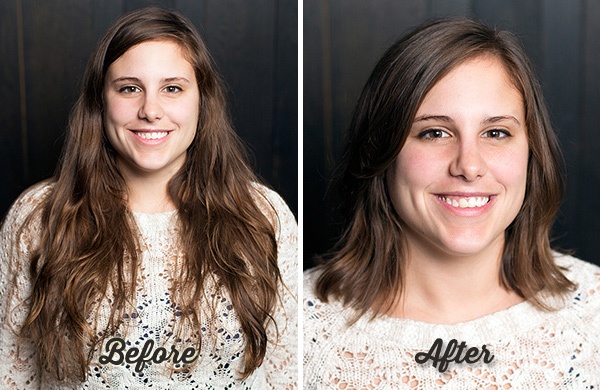
When she posed for the picture above, Jen was about to chop off most of her hair.
“I can’t run my hands through it anymore because it’s too gross,” she explained. She also hadn’t had a haircut for more than a year, and before that, her cuts had been mostly subtle trims. She was ready to change things up.
What Jen wanted out of her hair makeover was simple: long layers; long, angled bangs; something that fit with her wash-and-go lifestyle; and a cut that was still long enough to put up in a ponytail. Holding onto this length was key because, according to her, she has a “small head and broad shoulders”—a too-short cut would make her “look like a Goomba.”
Jen agreed to let me and a video team accompany her to her haircut at Art+Science. (She’s an editor at Groupon, which made our request to follow her less outlandish.) So, just after Chicago’s epic blizzard, we headed out to the Wicker Park salon.
Even right beforehand, Jen was pretty calm. The worst-case scenario she could imagine was a new cut that was always hanging in her face. But if that happened, she reasoned, she could just wear a hat for the rest of the winter.
She guaranteed that whatever happened, she wouldn’t cry.

Major haircuts aren’t always as casual as Jen’s. I conducted an informal survey about transformative haircuts, and people’s feelings often ran quite high.
“I almost died, cried, puked,” one respondent said, referring to a gig as a hair-show model that left her formerly shoulder-length hair an inch long.
Another said that her most extreme haircut—a completely shaved head “except for my bright red bangs, which I styled into devil horns”—was a reaction to a breakup. She had just “run out of things to pierce or dye.”
Yet another respondent cut her hair out of a very niche type of frustration: “I'd been kind of bored with my hair for a while, but the final straw came when I was sewing the hood for my Dilophosaurus Halloween costume and it just wouldn't look right with my bangs.”

Men also had strong feelings about their haircuts. Possibly my favorite response came from a guy with long, flowing hair whose stylist couldn’t shake the (mistaken) impression that he wanted to look more business-like. He left with a cropped, banker-appropriate haircut and a heavy heart. “The 15-minute walk home from the [barber] shop was the coldest walk of my life, and I was filled with regret. I liked my long hair. It was interesting.”
Luckily, when he got home, “My then-fiancé was very complimentary. I generally forego aesthetic compliments in favor of telling people what I like about their personality, and appreciate the same in return. Sometimes, though, I just need to hear that someone thinks I'm pretty.”
This thought gets at the wonderful and terrible power of haircuts: they can shake up your opinion of how pretty you are. Sometimes, they shake it up for the better. But when things go wrong—as they did for the Friends fan who said “I went in for the Rachel [cut] and came out looking like Ross!“—they shake it up, at least briefly, for the worse.
Luckily for all of us, hair grows. It’s quite good at that.

Before Jen’s cut at Art+Science, I talked with Tara Hulka, her stylist-to-be. Tara has been a stylist for the past 15 years, and she’s done her fair share of major cuts.
She’s also refused some major-cut requests—typically, when a person wants to chop off their hair in a fit of passion. “I can tell right off the bat that they’re super emotional,” Tara said. Some of those clients had just been through a breakup; others had just found out that they were pregnant. Regardless of the catalyst for the cut, Tara avoids making a big change in those cases. And her instincts tend to be sound: “Ninety-nine percent of the time, [the client has] come back after and said thank you.”
One sign of an overly impulsive client is a lack of vision for the cut. “What if my hair was gone?” is a starting point, but it’s not a fully fleshed-out haircut request. Here are some other questions to ask yourself before you make a big change, courtesy of Tara.

- How much maintenance am I ready for? Short hair, counterintuitively, requires more attention. “People who have long hair can just come in [for a cut] seasonally, four times a year,” Tara said. With short hair, you’ll need cuts every 4–6 weeks.
- Do I have a picture of the look I’m aiming for? It helps the stylist, and Google Image searching is easy. We found this picture of a lizard mohawk in two seconds.
- Does the look I want fit my hair texture? “A lot of times, people will bring in pictures, and it’s a different texture [than theirs],” Tara said. This puts her in a tough spot, so make sure your vision is realistic.
- Are the winter blues getting you down? No shame. A cut might cure them! “The amount of hair we’ve been cutting off in January is crazy. Even [on] guys,” Tara said. “I think with [Chicago] winters being so bad, people are just stuck in a rut and want a big change.”
The good news? If they’ve weighed the pros and cons beforehand, people are usually excited by their new cuts. “I’ve never had tears,” Tara said.

If haircuts and crying don’t seem linked to you, keep in mind that hair isn’t just something that grows irrepressibly out of your head. It also has social meaning, especially for women. As sociologist Anthony Synnott claims in his 1987 paper “Shame and Glory: A Sociology of Hair,” long hair is an important symbol of traditional femininity.
As evidence, Synnott supplies a few striking anecdotes. Here’s one: “One woman who had lost her hair following radiation treatments for cancer said: ‘When you lose your hair, you feel like you have nothing to live for.’”
Here’s another: “Indeed so powerful is the symbolism [of hair] that a secretary in New York, whose long hair was shaved off completely by a jealous wife, was awarded $117,500 in compensation.”
However, in the same paper, Synnott points out that “[c]hange is … the essence of fashionable and conventional femininity,” as defined by women’s magazines like Vogue. According to these publications, women should change up their cuts regularly and change their hair styles as often as possible. For the regular Vogue reader, it’s hard not to know about the subtle differences between “daytime hair” and “date-night hair.”
So, in summary: women’s haircuts should ideally be long but also constantly changing. It’s a bit of a Catch-22, and for women it’s hard not to feel its pull. It’s no wonder people occasionally shed tears after haircuts: hair affects how we see ourselves—and not just our physical selves.

The politics of hair might be fraught, but hair appointments, even for major hair changes, are considered a fun luxury. That’s because in salons, the client is in control—there’s nothing tragic about getting your hair to look how you want it to. (At Art+Science, it’s also partially because they give you free cinnamon tea.)
Jen’s appointment was certainly luxurious. Watch her (sped-up) haircut here:
Per her guarantee, she didn’t cry. She loved the cut and afterward looked utterly un-Goomba like. An unexpected perk? “My head feels lighter now,” she said.
Before we wrapped up our shoot, I asked her if she had any advice for people considering a major haircut of their own. “Just do it,” she said.
Tara agreed that there’s nothing quite like a brand-new cut: “It can almost make you walk a little different.”

Photos by Andrew Nawrocki; graphics by Lisa Ladehoff, Groupon
Know the facts before you head to the salon:

















